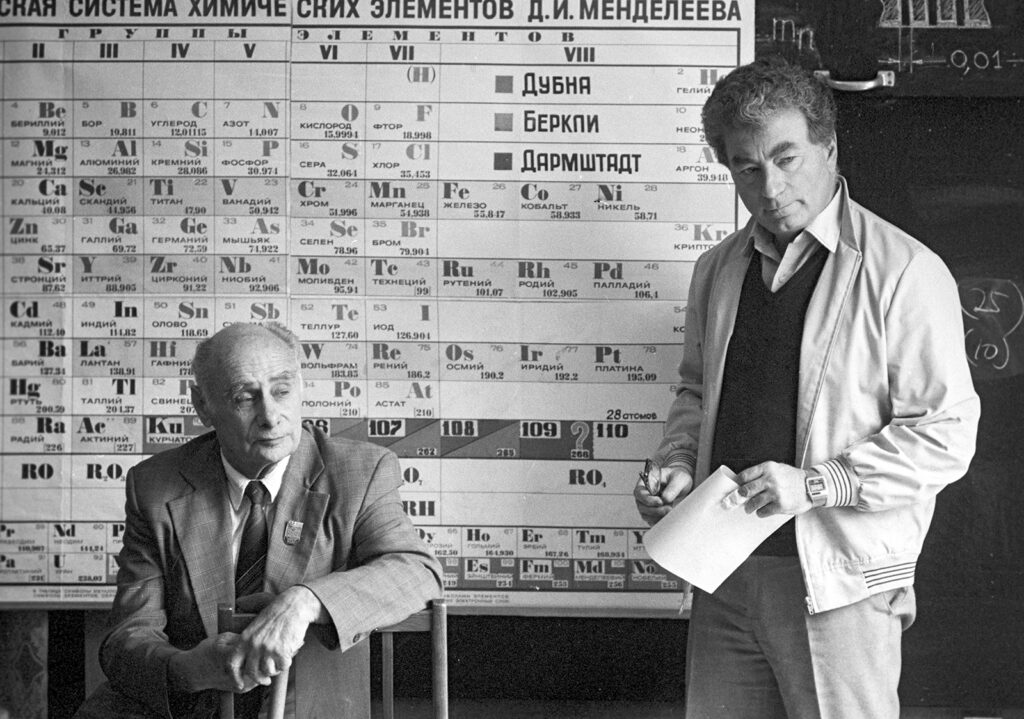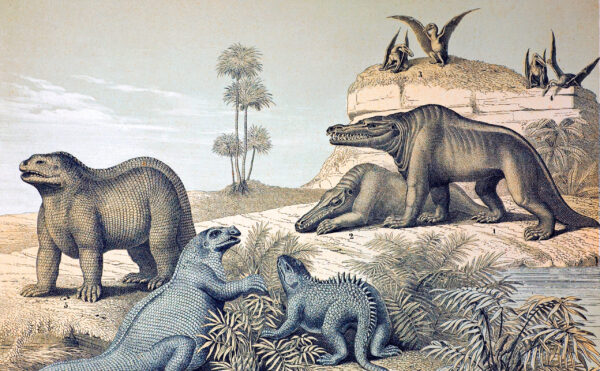The transfermium era began on a diplomatic note. Researchers from the University of California Radiation Laboratory in Berkeley officially announced their discovery of element 101 in 1955. It was fitting, they said, that this new element should be named after the Russian chemist Dmitri Mendeleev. He had been, wrote Albert Ghiorso, “the first to use the periodic system of the elements to predict the chemical properties of undiscovered elements.” Honoring a Russian was a bold yet politic move on the part of the Americans. Ghiorso, one of the leaders of Berkeley Lab’s heavy-element program, later recalled a French chemist telling him that “naming element 101 in honor of a Russian scientist had probably done more good for international relations” than anything the U.S. government had done up to that point. This goodwill, unfortunately, was not to last. The naming of later transfermium elements—so called because they come after element 100, fermium—would be mired in decades of rancor.
Traditionally, elements were named after mythological figures, astronomical objects, physical characteristics, or the minerals in which they were found. Hence we have beryllium, found in the mineral beryl; uranium, named after the planet Uranus; and indium, named for the indigo-blue line seen in its spectrum. Elements also acquired names from the places they were found. Ores found in Ytterby, an old mining town in Sweden, led to the discovery of four elements: ytterbium, yttrium, terbium, and erbium. But only rarely were elements named after people. This changed with the discovery of elements that were created in laboratories rather than found in the earth.
All the created elements, beginning with element 95, have been named after people or places connected to their creation. This change in convention may not seem significant but for the fact that most of the transfermiums were first created during the Cold War. Until the 1980s only two laboratories had the means to create and detect heavier and heavier elements. One was the Berkeley Lab in California; the other was the Joint Institute for Nuclear Research in Dubna, Russia. The researchers gained immeasurable nationalistic prestige, not only for their discovery but also for the power of naming the new element. It is hardly surprising, then, that such events ignited controversy.

The naming of elements 95, americium, through 101, mendelevium, went uncontested. Trouble began to simmer in 1957 when a collaboration among three research institutions—the Argonne National Laboratory in Illinois, the Harwell Laboratory in Britain, and the Nobel Institute for Physics in Sweden—announced the creation of element 102. They proposed the name nobelium, which was swiftly accepted by the International Union of Pure and Applied Chemistry (IUPAC), the international body in charge of christening new elements.
The groups in Berkeley and in Russia attempted to confirm the discovery but found it tricky to replicate. As an atom gets heavier with the addition of more and more protons and neutrons, its nucleus becomes less and less stable. This means it exists for ever-shorter periods—sometimes minutes, sometimes fractions of a second—before breaking down. Such an element is said to decay into daughter and granddaughter products. Some of these products are lighter elements, and some are particles. Complicating matters, the transfermium elements are difficult to create and are often made one atom at a time. This scarcity, combined with their short half-lives, makes them difficult to study, much less to detect in the first place.
So it is no surprise that neither the scientists in Berkeley nor those in Russia could reproduce the original results. Instead, using different methods, each group announced in 1958 that it had independently created element 102 and thus was its discoverer.
The labs in both Berkeley and Dubna claimed the traditional right of discoverers to propose a name for the new element. The Berkeley Lab ultimately agreed with IUPAC that element 102 should remain nobelium. The Russian group, however, pressed for a change. They suggested joliotium, after Frédéric Joliot-Curie, the French physicist who, with his wife, Irène, discovered artificial radioactivity and won the Nobel Prize in Chemistry. Joliot also had a reputation as a committed Communist. IUPAC refused to change the element’s name, which still appears on the periodic table as nobelium. The Soviets were aggrieved.

Much of the discord between the Dubna and Berkeley groups stemmed from the different methods each used to create new elements. These methods were new, and not everyone agreed they were equally valid. One method used by the Soviets to identify new elements was spontaneous fission, in which very heavy atoms spontaneously break down into smaller and lighter atoms and particles. Georgy Flerov, a Soviet nuclear physicist, discovered the method in 1940. The Americans, however, did not believe that measuring spontaneous fission activity alone could establish that an element had been created. Instead they preferred to work backward from the products of the decay to determine what heavy element had been created.
The battles around elements 104 and 105 proved particularly vitriolic and were later dubbed the Transfermium Wars. The tensions between Dubna and Berkeley boiled over in personal clashes at international conferences, in conference papers, and in journal articles. In the hope the two sides would resolve their differences, a meeting was convened in September 1975; it ended with Glenn Seaborg, a major figure in nuclear chemistry, accusing the Russians of not taking the Americans seriously. In May 1976 an informal meeting between Ghiorso and Flerov exploded into confrontation, increasing the level of antagonism. Later that year Ghiorso stated that the Berkeley Lab would cease to confirm or deny the validity of the results obtained by Dubna. “We know now that it is a thankless chase and wasteful of scientific talent,” he said, “and we do not intend to pursue this any further with other elements.”

Another controversy—over element 106—occurred not between Berkeley and Dubna but between Berkeley and IUPAC. In 1994 the Berkeley group proposed naming element 106 after Seaborg, who had been instrumental in the discovery of several elements. He was also very much alive at the time. Although IUPAC had no preexisting ban on naming elements after the living, it decided not to set such a precedent, wanting to allow for the “perspective of history.” This decision didn’t go over well with the Americans, and after an intense letter-writing campaign organized by friends of Seaborg, IUPAC reversed its decision. Element 106 was named seaborgium, an act Seaborg described as the “greatest honor ever bestowed upon me—even better, I think, than winning the Nobel Prize.” (Only one other element has been named after a living person: element 118 was named oganesson in 2016 after Yuri Oganessian, a pioneer in heavy-element research at Dubna.)
So who actually discovered elements 102 through 109, the question at the heart of all this ill will? It took a group of physicists and chemists, convened in 1986 by the International Union of Pure and Applied Physics and IUPAC, to settle the matter. This Transfermium Working Group drew up a list of highly technical criteria for determining whether an element had been discovered. Then it applied those criteria to elements 101 through 109 and divvied up credit for discovery. Those criteria are still in effect, allowing elements 110 through 118 to be named without major controversy.
The Cold War may be over, but the era of transfermium elements is not. As the search for new elements continues, the field has widened. GSI in Darmstadt, Germany, discovered elements 107 to 112. Element 113 was produced by Riken in Japan. The Dubna group, collaborating with the Lawrence Livermore and Oak Ridge National Laboratories, created elements 114 to 118.
Creating new elements is hugely expensive. So why do countries continue to invest millions of dollars to produce new elements that are of no practical use? One obvious answer is national prestige, along with the prestige of the scientists and the laboratories for which they work. When asked, scientists say they are seeking to answer fundamental questions, such as how many elements are possible and what the limits are of the stability of matter. The search for new elements also pushes the development of techniques and instruments that can be used for other scientific investigations. But perhaps the most telling answer is the one provided by the Berkeley Lab’s Ghiorso: “You do it because people are curious.”




